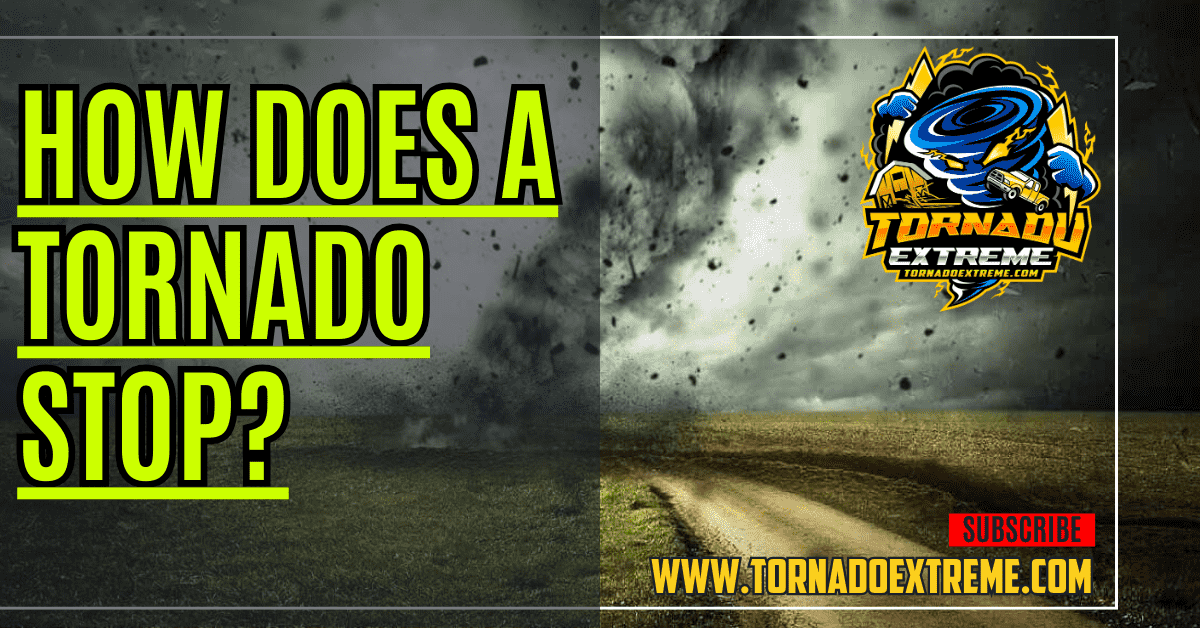How Does a Tornado Stop? Unraveling the Mysteries Behind Tornado Dissipation
Throughout my time with the National Oceanic and Atmospheric Administration (NOAA) and NASA, I’ve been asked repeatedly about what makes tornadoes end, a common question in the tornado FAQ sections. It’s an intriguing process that is deeply ingrained in the storm’s interior dynamics itself and how it interacts with its environment, crucial in understanding how tornadoes occur. When a tornado begins to dissipate, it’s simply because its supply of warm, damp air – essentially the fuel that keeps it going – becomes disturbed. This can happen due to several factors such as encountering cooler air or passing through terrain structures that hinder its progress or also when the parent thunderstorm starts to weaken.
Another factor that contributes to a tornado dying out is something called rear-flank downdrafts, which is nothing more than streams of cold air circulating around the backside of a twister that cuts off any source of warmth. I recall vividly witnessing this phenomenon while conducting a field study – It was almost like watching life being choked out of the tornado causing it to crouch up into nothingness. The process really underscores just how delicate these storms are when it comes down to conditions they need in order to keep their structure nice and strong, a key focus of the National Severe Storms Laboratory.
The Lifecycle of a Tornado: From Formation to Dissipation
The lifecycle of a twister is quite amazing if you ask me and something I had the pleasure of studying during my career. It all begins with a funnel cloud, which is simply just spinning masses of wind extending from cumulonimbus clouds but not yet touching ground level. A funnel cloud turns into an actual tornado once it makes contact with the Earth’s surface then goes on to develop destructive winds creating that characteristic funnel shape we’re all accustomed to seeing.
As time goes on with this rotating storm system, things start getting strange and erratic; its path isn’t straight no more nor does its formation still make sense. In fact, this is usually the final act of a tornado’s life where it starts running out of energy. The funnel cloud then turns into a thin strand resembling a rope; hence the term “roping out”. This means the twister is weak and won’t be around much longer before it eventually disappears entirely. Watching this stage occur during my research served as a sudden reminder that we should never underestimate the power and unpredictability of these types of storms.
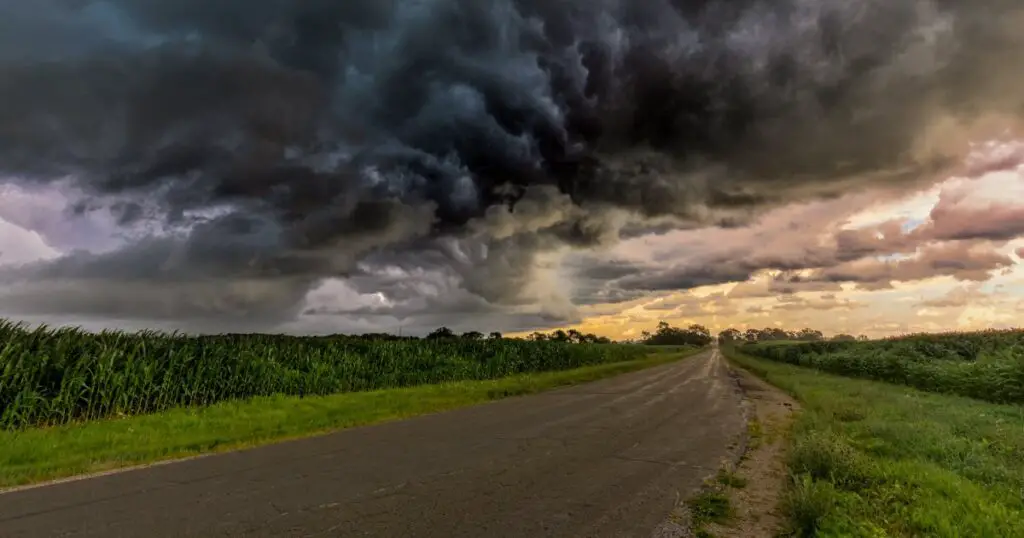
Knowing How Tornadoes Are Born: Understanding Storm Development
Being exposed to so many of these natural disasters has taught me that for one to form, it’s nothing short of an intricate dance between weather factors. It all begins with vertical wind shear which is basically just air currents moving very fast in different directions on the flip side, low level horizontal spinning occurs when pressure and temperature disparities create mass differeces on Earth’s surface. The combination of these two dynamics sets up an environment that nurtures supercell thunderstorms; known for producing some pretty strong funnels.
The spinning ball of wind needs something else though – A push almost – to make it take a vertical shape and form that signature funnel cloud we’ve seen too many times before. I’m referring to updrafts; or warm air rushing up quickly then tilting the twister’s base from horizontal to vertical orientation. Observing this shift was always interesting since it signals the beginning stages of what can be a very dangerous storm if given enough time. Authorities depend greatly on understanding how these early moments play out in order to properly forecast futures ones, saving lives in return.
See also: Tornado Facts: Unveiling the Mysteries of Nature’s Fiercest Storms
When the Storm Organizes: Setting the Stage for a Tornado
The process of going from a storm to a tornado is pretty intricate. A regular thunderstorm’s wind shear provides spin and tilt that eventually makes the storm turn into a supercell, which can spawn tornadoes. This shear affects the storm’s updraft and creates a rotating updraft called a mesocyclone. I’ve seen one form during my time at NOAA, and it was absolutely incredible, showing just how complex nature can be.
Meanwhile, spinning horizontally at ground level also happens when temperature and pressure differences come into play. This additional spinning could help the storm produce a tornado when it gets swept into the updraft of the supercell. As soon as this happens, a funnel cloud starts to form — an indicator that there may be a tornado on its way. The transition moments between unorganized storms to structured spinning systems are crucial in setting the stage for a tornado’s beginning.
The Final Act: How a Tornado Ultimately Stops
At first glance, it seems like figuring out what causes a tornado to stop would be impossible. After seeing many of them myself though, I’ve found that most of them die due to sudden disorganization within the storm — especially within the funnel cloud itself. When this happens, oftentimes either its warm air supply is cut off or cold air is added into its system. Both of these things cause energy loss and lift decrease, resulting in weakened winds until they disappear completely.
Sometimes though, rear-flank downdrafts from thunderstorms get tangled around the tornado itself and choke out its warm air inflow. Seeing one shrink before me emphasized how temporary these dangerous weather events really are.

Unveiling the Forces Behind Tornado Termination
As far as stopping goes, there are more factors than you’d think involved with actually getting rid of one of these things once it forms in nature. During my career observing them firsthand, I’ve noticed that any change in environmental conditions weakens their intensity little by little. For example, if the temperature and humidity levels around a tornado decrease, its energy will do the same.
If wind shear — which helped in the first place — drops off too much, the tornado will die out as well. Likewise, there are other circumstances that can end one’s path of destruction. Sometimes it’ll move from a flat area into hilly or mountainous terrain, which disrupts airflow and breaks apart its structure. In scenarios where a parent thunderstorm weakens its updraft or introduces cold air through downdrafts, the tornado will also disappear faster than you can blink an eye.
The most important thing I learned during my time at NOAA is that there’s always more to learn about these deadly storms. Each occurrence is unique in its own way; therefore, they all require detailed studies on what could cause them to weaken or vanish forever. Continued research leads to better predictive models which then help save lives by providing the most efficient warnings possible.
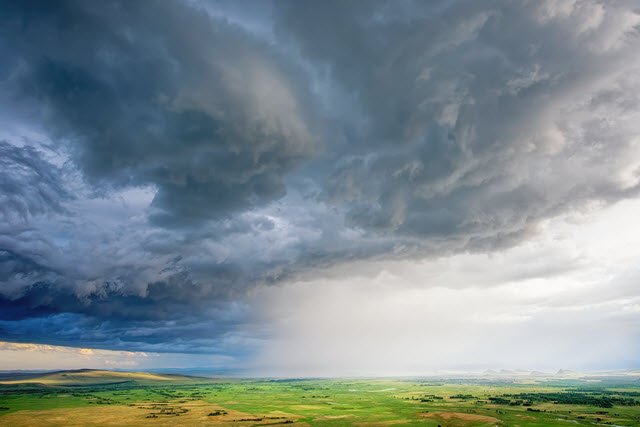
The Role of Environmental Conditions in Tornado Lifespan
Tornadoes can exist for varying durations, depending on the conditions they face. In my time working at both NASA and NOAA, I have seen firsthand how temperature, humidity, and wind shear can either increase or decrease a tornado’s lifespan. To thrive a tornado needs warm, moist air to feed off of. Any deviation from this will cause rapid weakening. When temperatures or humidity within the storm decrease it disrupts the energy that is supplying the tornado, leading to its death.
Wind shear initiates a tornado’s formation but also plays a part in its destruction. If wind shear drops significantly while the tornado is alive it will lose its rotation and weaken. Time after time observations have shown how crucial these factors are in determining whether or not a tornado lives, underscoring the unpredictable nature of tornado season.
The location where a tornado travels can also alter its life span as well. Navigating through rough terrain or encountering obstacles like hills and mountains can disturb airflow and structure of the twister. The interaction between environment and tornado has been critical in helping us learn more about this natural disaster as we continue to strive for better predictions and warnings.
How Temperature, Humidity, and Wind Shear Affect Tornado Duration
From what I’ve witnessed throughout my career it seems that temperature, humidity, and wind shear are all key factors to affecting how long a tornado will last for before dissipating into nothingness. Warm temperatures along with high levels of humidity allow it to form in the first place then sustain itself once it does come to fruition.. Cool things down too much though,and you’ll find yourself watching as your new born whirlwind starts fizzling out right before your eyes before finally extinguishing completely.
If wind shear changes direction/loses speed during these storms their structure will be compromised which could lead them to weakening themselves into submission or at best drastically bring down their overall strength.
See also: Which State Has the Most Tornadoes and Why It Matters
Tornado Alley: A Closer Look at America’s Tornado Hotspot
Tornado alley is a section of the United States I’ve spent substantial time analyzing. Spanning through the center, this region has become quite known for its frequent and menacing tornadoes. The area’s geological and climatic conditions –which are unique to this area- make it a hotbed for twisters. Most of them occur during the peak months of May and June. When warm air from the south mixes with cold air from the Rockies, severe thunderstorms develop, potentially leading to the formation of violent tornadoes during tornado season.
In this region, tornadoes are rated on a scale called Enhanced Fujita Scale (EF). Here they’re rated anywhere form EF0 to EF5 which indicates minor destruction or complete devastation, respectively. Mobile homes and structures that aren’t rooted to the ground are particularly vulnerable as they usually endure heavy damage or complete destruction by winds that reach over 200 mph.
The duration of these tornadoes can vary significantly— some last only up to 20 minutes while others persist for more than an hour. This unpredictability makes studying them difficult and predicting their path nearly impossible. But my studies have provided me invaluable insight into how these storms manifest and disband, often aligning with data from the National Weather Service on violent tornadoes.
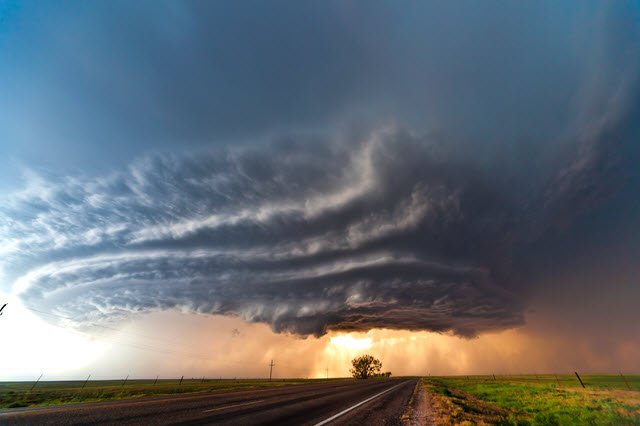
How Geography and Climate Affect Tornado Formation
Geography and climate have proven to be powerful forces in both the formation and disintegration of twisters. A funnel cloud often serves as an early indicator of a potential tornado, a phenomenon well-documented in the tornado FAQ section of the National Weather Service. These vortices form underneath water-loaded cumulonimbus clouds; fueled by contrasting temperatures and high levels of humidity in the atmosphere. Once full-fledged, these cyclones have enough might behind them to wreak havoc — indicated by its funnel-like shape.
The climate of Tornado Alley regularly brews such clouds which eventually manifest into fully-formed storms capable of causing chaos across vast sections of land.One contributing factor comes down to geography; as most regions here are flat with little obstacles in their way – allowing them to grow and move freely. However, when it bumps into terrain changes or different atmospheric conditions the storm starts to lose its power.
From flat plains to more varied landscapes, I’ve noticed how crucial these interactions are. The environment a tornado grows in affects both its lifespan and how much damage it can cause. Understanding this has been pivotal in uncovering the secrets of these complex storms.
Decoding Tornado Ratings: Measuring the Power of the Storm
I’ve always been fascinated by tornado ratings during my time spent working with NOAA. It’s truly mind-boggling that we’re able to measure their strength at all. Through various means of assessing damage, we’ve learned the potential impact that a tornado can have on human structures and the surrounding environment. This knowledge is crucial for building against future storms and improving safety as a whole, aligning with efforts to prevent tornadoes as advised by the National Weather Service.
The Enhanced Fujita Scale, or EF Scale, is an updated and more accurate version of the original Fujita Scale. It uses ratings from EF0 to EF5 to describe a tornado’s damage. The scale is crucial in my work because it helps me analyze the aftermath of each event and plan for recovery.

From F0 to F5: Understanding the Fujita Scale
The Fujita Scale was introduced in 1971 by Dr. Ted Fujita and revolutionized our understanding of how destructive a tornado can be. I first heard about it during my early years at NASA, and was amazed that it used wind speeds and estimated damage to classify these storms on a scale from F0 to F5. An F0 storm might only have winds as high as 72 mph, which can cause minor damage, while an F5 storm has winds strong enough to level well-built houses.
This scale not only tells us how much destruction an individual tornado can create, but also helps refine our predictive models. By comparing wind speeds with what we see on the ground, we can improve early warning systems in regions prone to twisters and save lives.
The Correlation Between Tornado Rating and Lifespan
When you look at a storm’s rating on the Fujita Scale, does that tell you anything about how long it will last? While higher-rated storms (F4-F5) tend to have more power and are potentially longer-lived than smaller ones (F0-F3), there is no direct correlation between lifespan and rating. Atmospheric conditions that make powerful storms possible sometimes result in weak ones instead — so just because a tornado starts out small doesn’t mean it won’t grow into something much bigger later on.
Even lower-rated tornadoes can persist for incredibly long times when they find themselves under ideal atmospheric circumstances after they form off initial updrafts being fed by unstable air masses along cold fronts— miles away from where those air masses originated. This variability is just another reason why it’s so difficult to predict the exact path and timeline of these storms — a challenge that keeps us meteorologists interested in our work.
See also: What is a Waterspout Tornado?
Severe Weather 101: Frequently Asked Questions About Tornadoes
While working for NOAA I’ve been asked countless questions about tornadoes, which attests to how fascinated and concerned the public is by these devastating storms. This has prompted me to refer to the National Severe Storms Laboratory for further tornado FAQs. A tornado is a violently rotating column of air in contact with both the surface and a cumulonimbus cloud, often visible as a funnel cloud. While some parts of the world are more prone to tornadoes than others (like the United States’ “Tornado Alley”), they can happen almost anywhere under the right conditions.
For example, many readers ask what a tornado warning means. It’s an alert issued by organizations like NOAA when someone sees a twister or weather radar detects one on its own. The goal is to give potentially affected people enough time to seek shelter from impending danger, utilizing forecasts and warnings from the National Weather Service during tornado season.
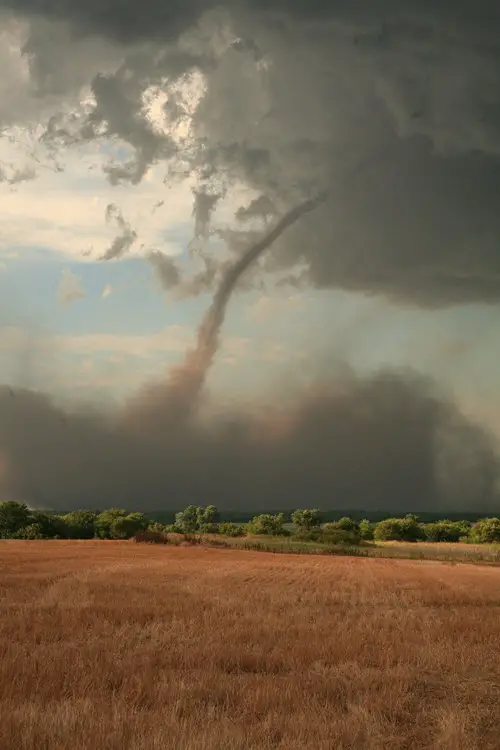
How Does a Tornado Stop?
Among all of tornadoes’ components — from their formation and life cycles, to their dissipation process — I find this last aspect particularly intriguing. How does such an immensely powerful storm suddenly stop? As you might expect, it happens when the conditions necessary for its existence change — like when warm, moist air stops flowing into it or if the whole storm system itself starts to weaken. My team at NASA has learned an incredible amount about this final part of twisters’ life cycle over my years working here, mostly thanks analyzing satellite imagery of dying storms.
It’s fascinating to see how the force of nature in tornadoes can just suddenly end and still give us some data that researchers like me can use to understand them better.
Why Do Some Tornadoes Last Longer Than Others?
I often get asked why some tornadoes last longer than others as I work with severe weather events. The answer lies within the different atmospheric conditions present when they form. Factors such as the amount of moisture available, temperature differences between ground and air, and wind shear can all influence a tornado’s lifespan.
For example, those that form in environments where there is high instability and plenty of warm, moist air tend to be more enduring. On top of that, if the wind shear – the change in wind speed and direction with height – is also strong it could further support the tornado’s rotation making it last even longer. These intricacies make predicting a twister’s duration challenging yet fascinating, and they’re often highlighted in advanced tornado FAQ discussions.
The Tornado’s Aftermath: Exploring the Phenomenon of Exploding Houses
It is both devastating and scientifically interesting seeing what’s left after these twisters pass through towns, especially when homes explode. The cause of this destruction tends to be rapid changes in pressure as a tornado passes over a structure. This swift motion causes buildings to burst outward as if they exploded showcasing just how powerful these storms are.
Learning about this science is crucial for developing safer building codes and practices. In doing so we will learn ways on how to protect homes better which could potentially save lives as well.
The Science Behind Pressure Differences and Tornado Damage
A big part of my studies has been understanding how things like wind speeds contribute to damage caused by twisters. As one approaches a building, pressure outside drops drastically while inside remains relatively high; this imbalance makes structures fail causing walls or roofs to cave in or blow away entirely. Wind speeds can reach over 300 mph during certain severe storms causing widespread destruction.
Understanding these dynamics about the wind and pressure is crucial for designing buildings that can withstand such forces. It is a combination of meteorology and engineering that helps save lives as it uses data from past storms to better prepare for future ones.
An In-Depth Look at Tornadoes and Thunderstorms: A Symbiotic Relationship
One thing about tornadoes is they don’t just appear out of nowhere, they are created alongside thunderstorms. Supercell thunderstorms to be exact which are highly organized with long-lasting and intense winds. The funnel cloud, often seen before a tornado forms, occurs when the storm’s updraft gets stronger, indicating these two types of storms work together. This interaction is a key focus in the National Severe Storms Laboratory research on how tornadoes occur.
Witnessing this formation happen while I was working in the field was an awe-inspiring moment. The process showed me how much energy goes into severe weather systems making it easier to understand why we need to learn more about them to protect our communities.
Wind speeds in these storms can reach up to 300 mph within the most extreme tornadoes, which is downright mind-boggling. That kind of energy doesn’t just fuel a tornado. It also makes the supercell thunderstorm more severe as a whole. Understanding how both processes work is crucial for improving our prediction models and saving lives and property, so this topic is definitely worth diving into.
The Crucial Role of Thunderstorms in Tornado Genesis and Extinction
When it comes to the genesis and extinction of tornadoes, we have to look at the lifecycle of thunderstorms — especially supercell thunderstorms. These storms are known for their rotating updrafts, which sounds scary enough on its own, but they actually provide an environment that’s perfect for tornadoes to form.
As air rises in this storm, wind speeds within it increase too. This rotation creates an upward suction that’s capable of forming a twister. But it’s not just about the start; it’s also about the end.
As a storm weakens, conditions stop being ideal for maintaining a tornado — such as dwindling wind shear and updraft strength. When those two factors die down entirely, so does the funnel cloud. In my research with EF scales, I’ve learned that understanding how both formation and dissipation work is crucial for accurately rating and assessing these rare weather events.

